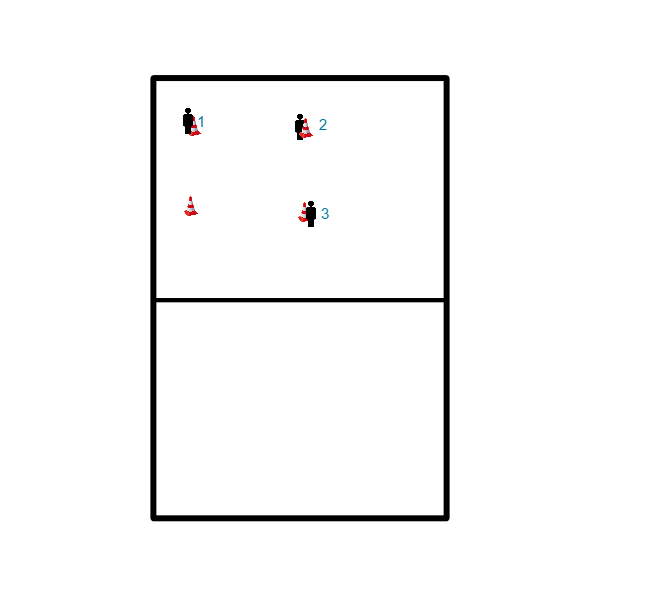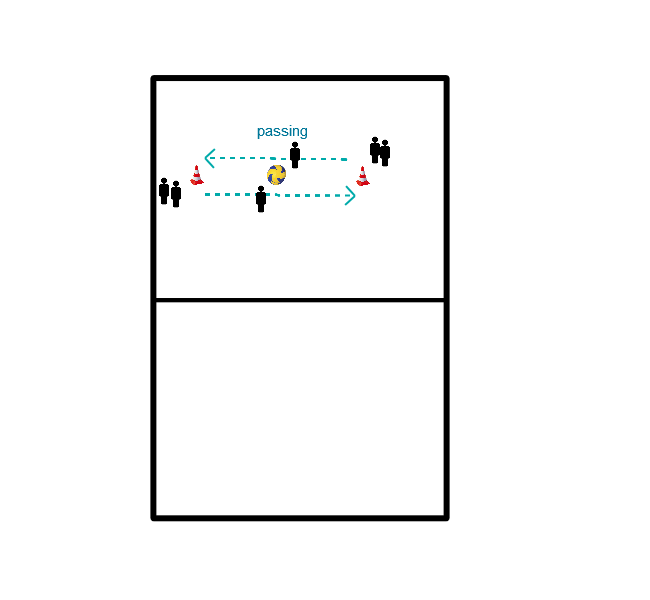Korfball drills for technique passing / attack
The team stands in a circle with one person in the middle.
The ball is played in from the outside.
You run after your ball.
From the middle back to the outside, also chasing the ball.
The ball must not come to the ground and you have to run as fast as possible.
If it does hit the ground then the person who threw the ball is going to take a penalty throwThe
rest of the team plays on
Variation:
- Alternate preferred hand with non-preferred hand.
- Shorten or lengthen the distance to the centre.
- Tight balls or curve balls.
- With several balls
- All players stand in a circle.
- Player A throws the ball to player B, and then runs to player B's spot.
- Player B throws the ball to player C, and stands on the spot of player C.
Start in a small circle (close to each other) and make the circle bigger and bigger.
Can be done in 2 groups, which group can stand furthest apart without making mistakes?
- The trainer sets up two (parallel) rows of an equal number of players evenly spaced apart.
- Both rows face a basket.
- The ball starts with a player under the basket.
- The person in charge plays a short pass to the first in line in front of him, the receiver catches the ball and turns around to pass it to the next in line.
- When the ball has reached the last player in line, he passes it back to the player 2 spaces ahead of him, etc., until the ball has reached the player in front of the basket, who takes a short shot.
- The shooter then takes the place of the declarer who then closes in behind as quickly as possible.
Variant:
- When the ball has reached the last in line (farthest from the basket), the declarer comes to support (high, depending on distance).
- The last player in line passes the ball to the attacker and starts a sprint for a walkthrough.
- The player is allowed 1 rebound attempt.
- A scored walkthrough ball is worth 3 points, a short shot 1 point.
The team that scores the most points wins. The teams learn to discover that the BALANCE between pace and precision is important. Those with pace are likely to get more chances, but those in a hurry pass inaccurately and may not finish the chances, requiring even more time. A fun game with a competitive element!
- The trainers have the children warm up in a fixed pattern (round or square).
- The children run behind each other with some distance between them.
- The child in front receives the ball from the trainer.
Variant 1
- While running, the ball is passed to the next person in line by means of a throw (short pass), the receiver passes the ball to the next person in line.
- The person in the back passes the ball back to the last thrower and the ball travels the whole route in reverse order.
- Emphasise technique where necessary and ask which form of passing is most effective.
Variation 2
- Similar to variation 1, but now the ball is passed backwards without looking (i.e. by feel).
- The emphasis now is on catching and uncatching the ball.
- The last player in line to receive the ball sprints with it to the front to start a new round.
- So there is always someone else in front.
Extension
: To make it a bit more difficult, you can appoint 1 or 2 defenders who make it more difficult to throw and try to intercept.

In short:
A trio has to pass the ball to each other in a square.That is tricky yes, because one is always missing....
Organisation:
Three players stand in an imaginary square about eight metres from each other. One corner remains unoccupied. The middle player (number 2) of the three has the ball.
Start in square. In from (basic
) Later: 1 under the post.
Basis: always offer sides. Not in a clump, not too early, not too late.
Inshort: simple catching and throwing exercise with a lot of running for foursome.
Organisation: The four players form a square (distance about 10 metres, depending on the level), one of the four has a ball. If there are people left over, one or more foursomes can be formed and stand in a pentagon. Almost all parts of the exercise described above can be practised in this form of organisation.
The procedure is as follows:
Player A throws the ball to B, runs after him, gets the ball back and throws to C. He gets the ball back, plays to D, gets the ball back and throws to B over quite a distance, and finally takes his original place again. In the meantime B has already started his round. When everyone in every foursome has had 3 turns the next exercise comes.
Variations:
- The players walk the other way.
- The attackers move slightly to and fro.
- Which foursome will finish fastest? (everyone has to walk three times).
- Make sure that the distances do not suddenly get smaller!

- Place the hats about 6 meters apart. Divide the group in 2.
- In case of five a group of three and a group of two.
- Goal is to keep the ball in the middle of the hats at all times.
- As soon as a player receives the ball, the player from the other side must be at the same level as the middle.
- After passing the ball, join the back of the queue at the other side.
- NB: nobody stands still and estimate well.
- Do not arrive too early or too late.
- Throw from the move.
- After five minutes also go the other way (left hand side).
Extra material: ribbons.
The game is played with 8 players, if more are present, then the players are changed after each attack. Everyone will be changed once, even if it means that a lady will play against a gentleman.
During the game (4 against 4) the emphasis is on what has been learned during the training: throwing and catching in a 4-0 situation. The defense is passive. Before a player walks to the basket, he must first pass the ball 10 times.
Goal is to play the ball into the hands of another player.
Make two pairs. Each pair stands 7 metres apart and passes the ball with one hand. As soon as one pair succeeds, both players can take 1 step backwards.
To train throwing with 2 hands and with the less good hand, the trainer calls out: now 3 times with the other hand / now 3 times with two hands.
! Form two groups. The attacker receives a vest.
This is louging in a korfball way. One person is the attacker, she/he starts with one defender. Within a playing area she/he must try to get free. In front of the box is the attacker. She/he has to make sure the ball gets to the attacker in the box. The other players stand aside. If the attacker receives the ball without the defender intercepting, a defender comes on board.
- Running free
- Throw
- Contact
The organisation in the following exercises is that two players face each other. One ball per pair. The distance can be varied, but players should not practice at maximum distance. Do not let the players stand too 'stiff', they must be able to move freely and relaxed.
Exercise 1
Players throw the ball to each other with two hands and catch with two hands. Position at chest height. Pay attention to either throwing or catching, not both at the same time.
Variations: which pair can throw back and forth 25 times the fastest, who can pass the ball over the most without dropping it.
Exercise 2
As exercise 1, but pass the ball a little higher, not so high that you have to jump, so just above your head. Pay special attention to the catch and the position of the thumbs, a little closer together than in exercise 1.
Exercise 3
Like exercise 1, but the ball is played at knee height. Pay special attention to the pins, slightly closer together and pointing to the ground.
Exercise 4
Have the players stand a little closer to each other and bounce the ball over.
Exercise 5
Players alternately throw the ball high, low, with a bounce or at chest height.
Variations
The same exercises can be performed at a greater distance. A nice variation is to have the players start close to each other and after 3 good tosses take a small step further apart. After a while the players
they will get far apart and the maximum distance will be reached. Let players throw at most 3 times at maximum distance, certainly not more or further.
At a distance of +/- 15 meter make two sections with 4 hats of 1,5 x 1,5 meter.
Make two teams with an equal number of players.
Each team has its own section.
The other team tries to conquer the box of the other.
This happens when one attacker stands in the box of the other and gets the ball from a teammate.
They get 1 point. No other players are allowed to stand in the box.
When the defence intercepts the ball, they may immediately open the attack on the compartment of the opposite team.
variation:
- on time
- on points
- from both teams 1 player allowed in the box
- no limit on number of defenders in section
- no limit on number of attackers in section
- adjust size of section
- distance between squares







